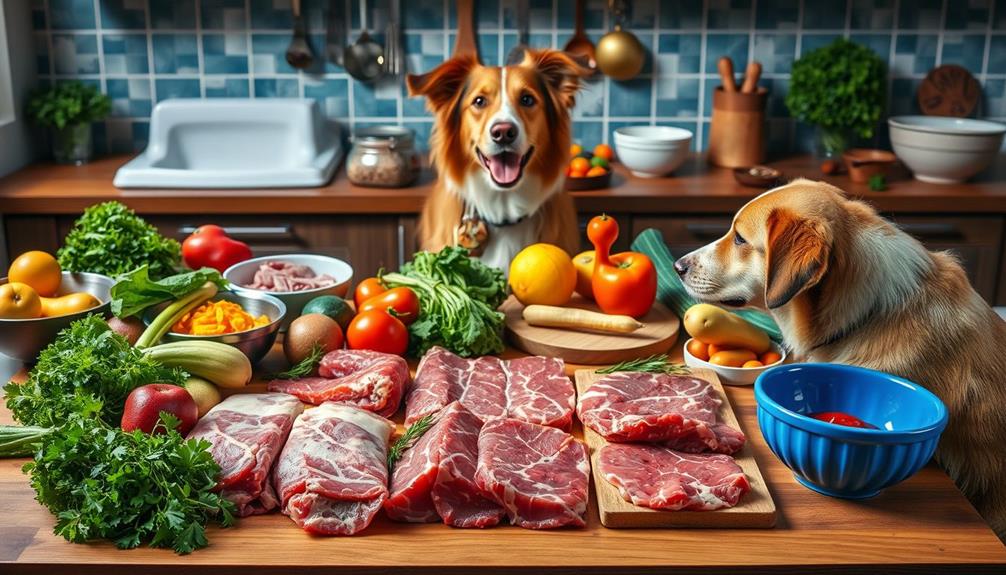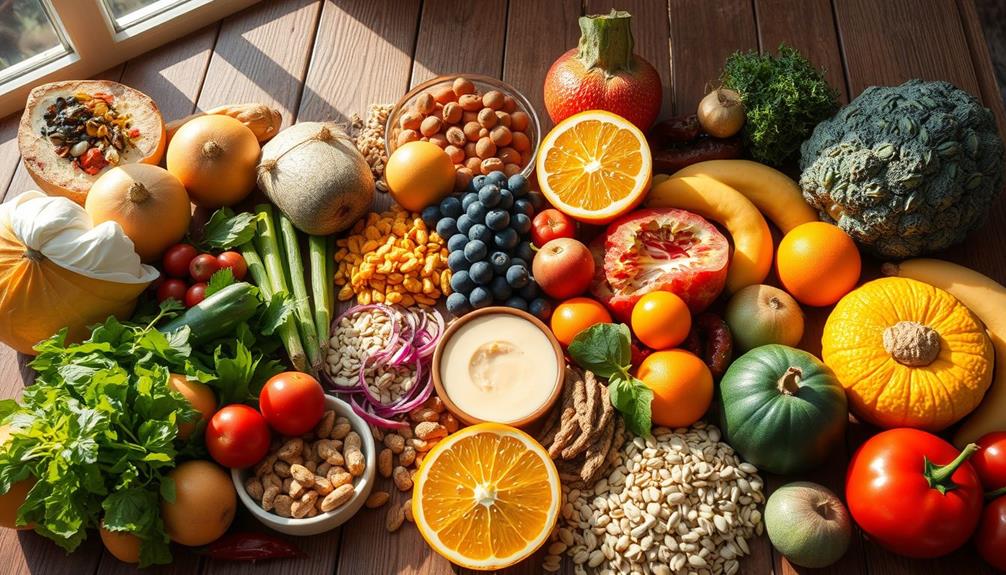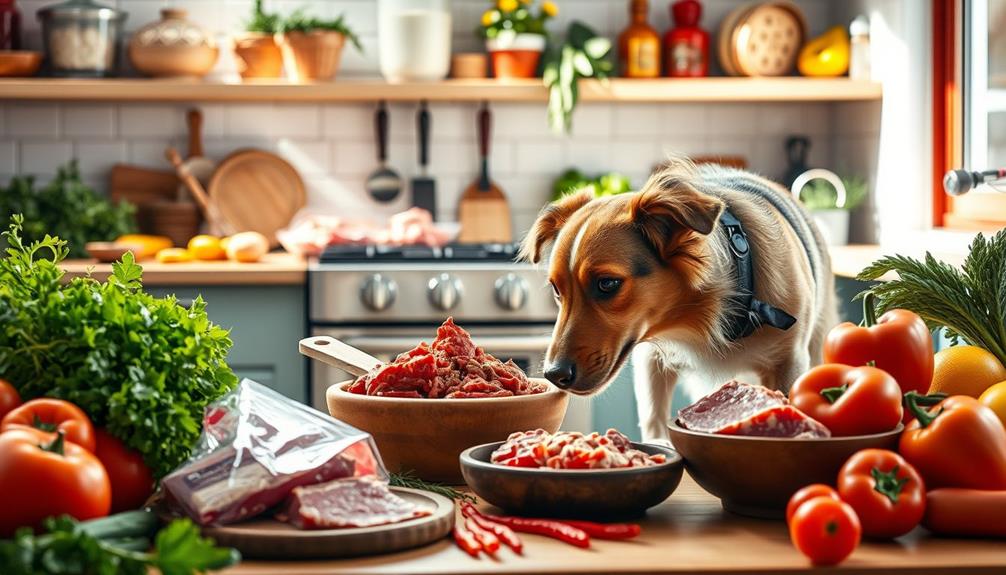Your dog can enjoy a variety of raw foods, including muscle meats like beef, chicken, and turkey. Include raw meaty bones for calcium and organ meats like liver for essential vitamins. You can also add safe fruits and vegetables, such as carrots and apples, for extra nutrients. It's essential to maintain a balanced diet, with 70% muscle meat, 10% bones, and the rest from organ meats and produce. Remember to handle raw food safely and monitor for any health issues. Stick around to uncover more details about preparing and adapting your dog to a raw diet safely.
Key Takeaways
- Dogs can eat muscle meats like beef, chicken, and turkey, which should make up 70% of their raw diet.
- Raw meaty bones provide essential calcium and phosphorus for strong bones and dental health.
- Nutrient-dense organ meats, such as liver and kidney, are crucial for vitamins and overall health.
- Selected fruits and vegetables, like carrots and apples, can enhance the nutritional balance of a dog's raw diet.
- Fish, particularly salmon and sardines, are excellent sources of omega-3 fatty acids beneficial for skin and coat health.
Understanding Raw Dog Food
Understanding raw dog food means recognizing how it can align with your dog's natural dietary needs. Raw dog food typically consists of uncooked meat, bones, and organ meats, providing a diet that closely resembles what your dog's wild ancestors would have eaten.
The BARF diet emphasizes a balanced composition, including 70% muscle meat, 10% raw edible bone, and a mix of liver, other organs, and vegetables. This balance is important for your dog's overall health, similar to how proper diet impacts hamsters.
When you're considering feeding dogs raw, it's crucial to include the right proportions of ingredients. Dogs have strong stomach acids and digestive enzymes that enable them to safely digest raw meat, making it a suitable option.
However, nutritional balance is essential; deficiencies can arise if organ meats and bones are underrepresented, which can lead to health issues.
For convenience, you might explore commercial raw dog food options. These products, like those from We Feed Raw, guarantee that meals are appropriately proportioned and safe for your pet. Considering a raw food diet for dogs can offer a range of health benefits, including improved digestion, healthier skin and coat, and increased energy levels. It’s important to do thorough research and consult with a veterinarian to ensure that a raw food diet is suitable for your specific dog’s needs and health conditions. With the convenience and peace of mind that commercial raw dog food options provide, it’s worth exploring this option for your pet’s overall well-being.
Nutritional Benefits of Raw Diets
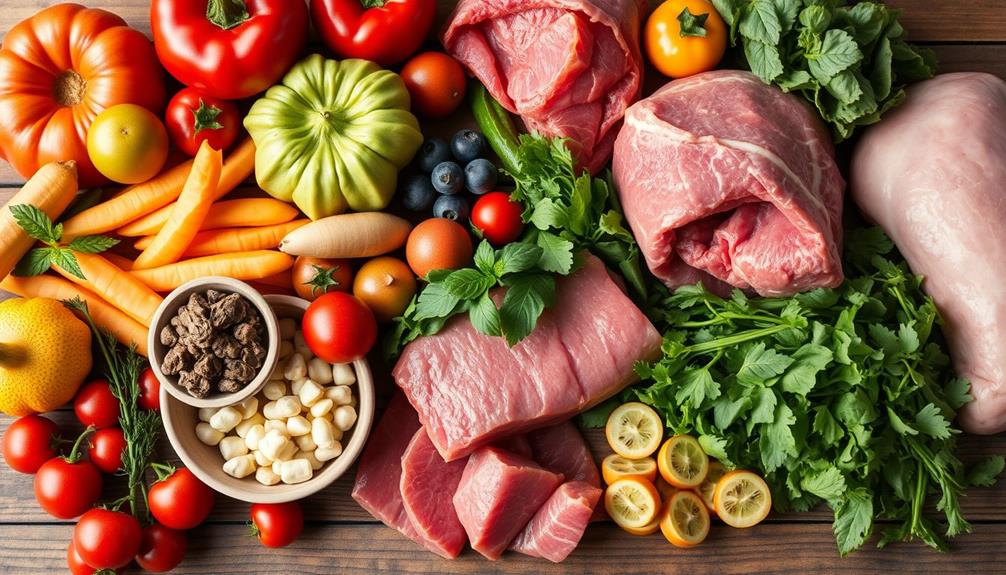
Raw diets offer a wealth of nutritional benefits for dogs, aligning with their natural dietary needs. By providing essential nutrients, raw diets support your dog's overall health and energy levels while promoting a happier, healthier life. Here are three key advantages of a raw diet:
1. Rich in Proteins and Omega Fatty Acids: Raw meat, bones, and organs are packed with high-quality proteins and omega fatty acids, which contribute to shinier coats and healthier skin.
Additionally, a balanced diet can enhance your dog's immune system, similar to the benefits of natural remedies alongside conventional medications.
2. Improved Digestion: Dogs on raw diets often experience better digestion and smaller, firmer stools. The higher bioavailability of nutrients and lower indigestible carbohydrates lead to more efficient nutrient absorption.
3. Enhanced Dental Health: Chewing on raw bones naturally cleans your dog's teeth, reducing tartar buildup and promoting healthier gums, which is essential for overall well-being.
Additionally, supplementing with fresh fruits and vegetables can further boost antioxidant intake, supporting your dog's immune system.
Types of Raw Food for Dogs

When it comes to feeding your dog a raw diet, there's a diverse range of food options to choose from. You can start with muscle meat like beef, chicken, and turkey, which should make up the bulk of their diet. The BARF (Biologically Appropriate Raw Food) diet suggests that 70% of the diet consists of muscle meat, ensuring your dog gets enough protein for energy and health.
Additionally, it's important to take into account financial planning for pet care, as a raw diet can be more costly than traditional kibble.
Incorporating raw meaty bones is essential too, as they provide critical calcium and phosphorus, supporting strong bones and teeth. Just remember to feed them in moderation to prevent choking hazards.
Organ meats, such as liver and kidney, are nutrient-dense and should make up about 10% of the diet, offering crucial vitamins and minerals.
Adding selected fruits and vegetables, like carrots and apples, can enhance nutritional balance. Don't forget about fish, such as salmon or sardines, which are excellent sources of omega-3 fatty acids that promote healthy skin and coat.
Always source your raw food from reputable suppliers and handle it properly to reduce the risk of bacterial contamination, ensuring a safe and nutritious diet for your furry friend.
Safe Preparation Methods
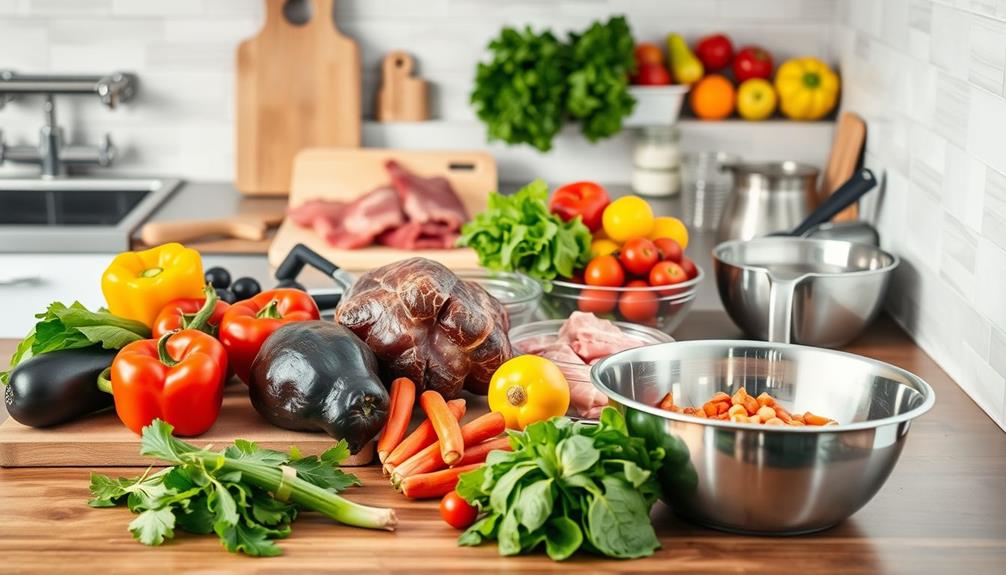
Feeding your dog a raw diet involves not just selecting the right foods but also guaranteeing they're prepared safely. Practicing safe preparation methods is vital to avoid bacterial infections and make certain your dog's health.
Maintaining a balanced diet for your dog is important to support overall well-being, which can be complemented by effective strategies for weight loss in managing their health. Here are three essential tips to help you:
- Separate Utensils: Use separate cutting boards and utensils for handling raw meat. This prevents cross-contamination between your dog's food and what you prepare for yourself.
- Fresh Ingredients: Always verify that the meat, bones, and organ meats you use are fresh and sourced from reputable suppliers. This greatly reduces contamination risks and helps avoid nutritional deficiencies in your dog's diet.
- Storage: After preparing raw dog food, store it in airtight containers in the refrigerator, consuming it within 2-3 days. If you need longer storage, freeze raw meat for at least 3 to 4 days before feeding to help kill parasites.
Health Risks of Raw Feeding
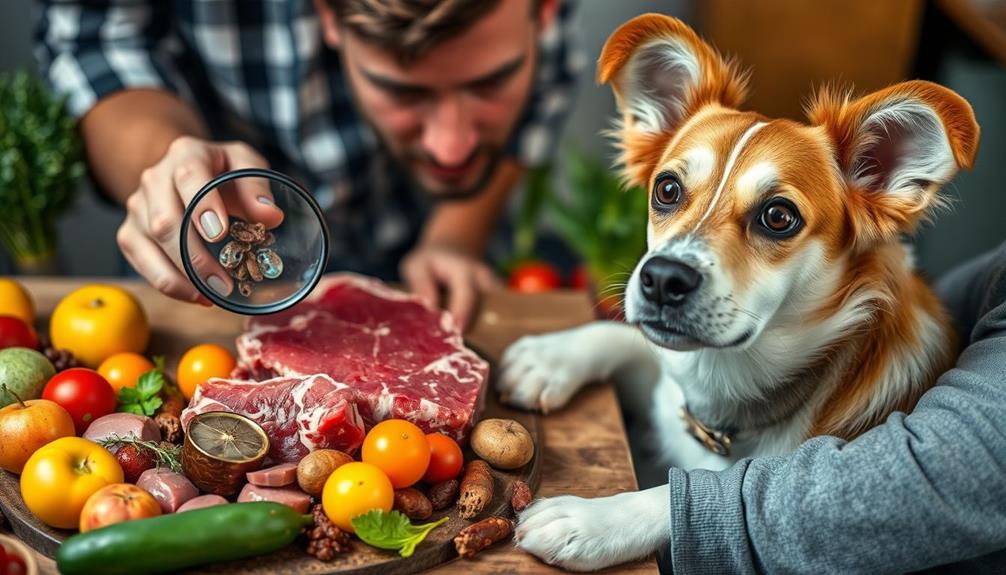
When you consider raw feeding for your dog, it's vital to be aware of the health risks involved. Bacterial contamination can lead to serious illnesses, and unbalanced diets might create nutritional deficiencies.
Additionally, understanding the importance of monitoring your dog's overall health and nutrition can aid in preventing potential complications, including emotional and psychological support for both the pet and the owner.
Plus, whole bones can pose choking hazards or cause injuries, so it's important to monitor what your dog consumes.
Bacterial Contamination Concerns
While many dog owners embrace raw diets for their pets, the risks of bacterial contamination can't be ignored.
Studies reveal that commercial raw diets often harbor dangerous bacteria, with about 20% testing positive for Salmonella and a staggering 64% for E. coli. This poses serious health risks not just for your dog but also for you, as these bacteria can lead to zoonotic infections.
Additionally, just as with investing in precious metals like Gold IRAs which require careful consideration of risks, raw feeding demands vigilance regarding food safety.
To guarantee food safety while raw feeding, consider these key hygiene practices:
- Thorough Cleaning: Always sanitize surfaces and utensils after handling raw meat to minimize cross-contamination.
- Proper Handling and Preparation: Wash your hands before and after handling raw food. Avoid touching other surfaces until you've cleaned up to prevent spreading bacteria.
- Freezing Raw Meat: While freezing can reduce harmful parasites, it doesn't eliminate them entirely, so verify you're sourcing meat from reliable suppliers.
Nutritional Imbalances Risks
The nutritional balance of your dog's diet is fundamental for their overall health, and raw feeding can often lead to significant imbalances. Many homemade raw diets struggle to achieve the ideal calcium to phosphorus ratios, especially in growing puppies, which can result in skeletal issues like nutritional osteodystrophy.
Furthermore, the emotional dysregulation associated with certain conditions, such as BPD, can parallel the instability that may arise from improper nutrition in dogs. Common deficiencies in raw dog diets include essential vitamins and minerals such as vitamin E, zinc, and iodine. Without proper supplementation, these deficiencies can lead to inflammation, impaired immune function, and thyroid problems.
Studies indicate that relying solely on raw diets may cause nutritional imbalances, leaving many dogs lacking necessary vitamins and minerals important for their health. The lack of nutrient verification in raw feeding practices can result in severe health consequences, making it imperative to consult with veterinarians or nutritionists. This helps guarantee that your dog receives a balanced diet.
Nutritional imbalances can manifest in various health issues, including poor coat condition, dental problems, and increased susceptibility to infections. Prioritizing a well-formulated diet is key to preventing these risks and maintaining your dog's well-being.
Choking and Injury Hazards
Raw feeding can present significant choking and injury hazards for your dog, especially when whole bones are involved.
These raw bones can lead to serious injuries, including broken teeth and intestinal punctures if not properly monitored during feeding. Additionally, the risk of harmful bacteria like Salmonella and E. coli is a major concern.
Studies show that nearly 50% of raw diets contain E. coli, and about 20% test positive for Salmonella, leading to bacterial contamination that can affect both dogs and humans. It's essential to recognize the importance of mammography guidelines for early detection of health issues, similar to guaranteeing safe practices in raw feeding.
To guarantee your dog's safety while raw feeding, keep these points in mind:
- Supervise dogs: Always watch your dog while they eat raw bones or large pieces of meat to minimize choking hazards.
- Avoid cooked bones: Cooked bones tend to splinter, posing a greater risk of choking and internal injuries.
- Choose suitable raw foods: Opt for raw diets that are low in harmful bacteria to reduce health risks.
Transitioning to Raw Food

Shifting your dog to a raw food diet can be a smooth process when approached correctly. The changeover period typically spans 7 to 14 days, where you gradually increase the raw food percentage in their diet. Incorporating nutrient-rich foods such as vegetables and fruits can enhance your dog's health during this shift.
Start by feeding 20% raw and 80% of their current food for the first three days. Then, adjust to 40% raw and 60% current food for the next three days, continuing this pattern until you reach 100% raw.
It's important to monitor your dog's weight and overall health during the changeover. Some dogs, especially healthy adult dogs, adapt quickly, while senior dogs or those with health issues may need a more gradual changeover to avoid gastrointestinal upset and digestive disturbances.
Consulting a veterinarian or animal nutritionist beforehand can help guarantee your dog receives a balanced nutrient intake throughout this process.
Recommended Feeding Guidelines
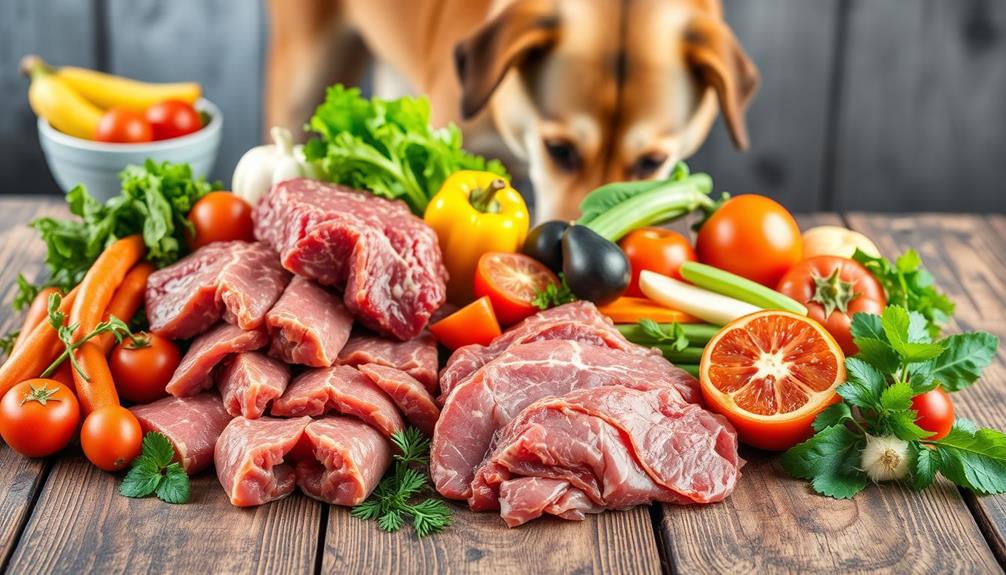
As you adjust your dog's diet, it's important to establish clear feeding guidelines to guarantee they get the right amount of nutrition. A raw food diet can be beneficial, but proper proportions are vital. Here's a simple breakdown:
1. Daily Amount: Dogs should eat 2-5% of their body weight in raw food daily. Active or younger dogs might need more than 3%, while senior or inactive dogs may require less than 2%.
Making sure your dog maintains a healthy weight is essential for their overall well-being, and monitoring their energy levels can help you make necessary adjustments. Healthy dog snacks can also complement their raw diet.
2. Diet Composition: Aim for a balanced nutrition profile: about 70% muscle meat, 10% raw edible bone, 5% liver, 5% other organs, and 10% fruits and vegetables.
3. Adjustment Plan: When changing to raw food, start with 20% raw and 80% current food for three days, gradually increasing raw food until you reach 100% by day 12.
Always remember to monitor your dog's health during this process. Regularly check their weight and overall condition to confirm they're adapting well.
Additionally, using online raw food calculators can help you determine personalized feeding amounts based on your dog's age, weight, and activity level, confirming a successful raw meat diet.
Cost-Effective Raw Feeding Tips
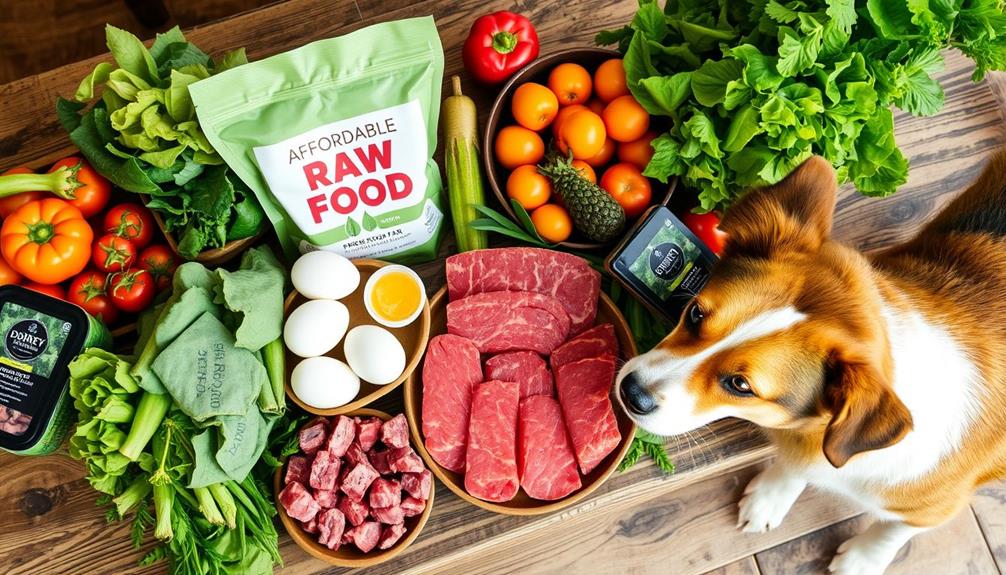
When it comes to raw feeding, you can save money with some smart strategies.
Buying in bulk, opting for affordable protein sources, and preparing meals yourself can all keep costs down while still providing your dog with nutritious food.
Let's explore how these tips can make raw feeding more budget-friendly for you.
Bulk Buying Strategies
Buying raw food in bulk can be a game changer for dog owners looking to save money while providing the best nutrition for their pets. By making bulk purchases, you can greatly reduce costs per meal for high-quality raw food, including meat, bones, and organ meats.
Here are some strategies to keep in mind:
- Build Relationships with Local Butchers: By establishing connections with local butchers, you can access better prices on bulk purchases and find off-cuts and raw bones that are often more economical than store-bought options.
- Join a Cooperative: Teaming up with other pet owners in a buying club or cooperative allows for larger bulk purchases, leading to discounted rates on high-quality raw food.
- Utilize Online Retailers: Take advantage of online retailers specializing in bulk raw pet food. They often provide competitive pricing and delivery services, saving you time and effort in sourcing ingredients.
Lastly, don't forget to freeze portions of your bulk purchases. This guarantees freshness and convenience, so you always have a supply of raw food ready to serve your furry friend!
Affordable Protein Sources
Finding affordable protein sources is essential for maintaining a budget-friendly raw feeding regimen for your dog. By incorporating cost-effective options, you can guarantee your furry friend gets the nutrition they need without overspending. Here are some great choices:
| Protein Source | Description |
|---|---|
| Chicken Backs | Inexpensive and packed with essential nutrients. |
| Ground Meats | Buy turkey or beef in bulk for savings. |
| Organ Meats | Local butchers often offer liver and kidney at reduced prices. |
| Fish | Canned sardines or mackerel are economical and rich in omega-3s. |
Utilizing seasonal produce and leftover vegetable scraps from your meals can also supplement your dog's diet at little to no extra cost. These affordable protein sources not only enhance your dog's raw feeding experience but also promote their overall health. By being mindful of your purchases, you can create a balanced diet that keeps your dog happy and healthy while sticking to your budget.
DIY Meal Preparation
Preparing raw meals for your dog can often be a rewarding experience that saves you money while guaranteeing your furry friend gets the best nutrition.
With a little planning and creativity, DIY meal preparation can become a breeze. Here are three cost-effective tips to get you started:
- Bulk Buying: Purchase cheaper cuts of meat, raw bones, and offal from local butchers. Buying in bulk markedly reduces costs and guarantees you have fresh raw ingredients ready for your homemade diet.
- Portion Sizes: Use online raw food calculators to determine the right portion sizes for your dog's weight, age, and activity level. This helps maintain a balanced diet while maximizing nutrition.
- Incorporate Whole Foods: Add fruits, vegetables, eggs, and fish to your raw dog food. These whole foods not only enhance nutrition but also provide additional health benefits without breaking the bank.
Veterinary Insights on Raw Diets

Veterinary insights on raw diets reveal a mix of caution and concern among professionals in the field. Major veterinary associations, like the American Veterinary Medical Association (AVMA), highlight significant health risks associated with a raw dog food diet. Bacterial contamination is a primary concern, with studies showing nearly 20% of commercial raw diets testing positive for Salmonella, posing risks not just to dogs but also to humans.
Many veterinarians recommend consulting nutritionists when considering a raw diet. These experts can help guarantee that the diet meets your dog's nutritional needs and avoids deficiencies that could lead to serious health issues, such as nutritional osteodystrophy in growing puppies.
Furthermore, raw diets often lack essential vitamins and minerals, resulting in nutritional imbalances.
To mitigate the risks associated with raw feeding, the FDA emphasizes proper hygiene practices, such as thorough cleaning of surfaces and diligent handwashing.
Following vet recommendations and adhering to these practices can help you navigate the complexities of raw feeding while keeping your furry friend healthy. Always prioritize your dog's well-being by staying informed and cautious.
Frequently Asked Questions
What Kind of Raw Food Is Good for Dogs?
When considering raw food for your dog, focus on muscle meat, raw meaty bones, organ meats, and safe fruits and vegetables. Balance their diet to guarantee they're getting essential nutrients for peak health.
What Raw Food Should Not Be Fed to Dogs?
Did you know that 1 in 5 dogs experience health issues from improper raw diets? Avoid raw meats high in fat, certain fish, raw eggs, toxic vegetables, and cooked bones to keep your dog safe and healthy.
What Is the Difference Between PMR and BARF Diet?
When comparing the PMR and BARF diets, you'll find PMR focuses on pure meat, bones, and organs, while BARF includes fruits and vegetables for added nutrients. Choosing between them depends on your dog's specific health needs.
What Is the Best Dog Food for Guide Dogs?
Have you ever wondered what fuels a guide dog's incredible journey? The best dog food for them is high in protein, rich in omega-3s, and balanced with essential vitamins, ensuring they stay strong and healthy.
Conclusion
In a world where dogs thrive like ancient wolves, embracing a raw food diet can release their true potential. By understanding the nutritional benefits and safe preparation methods, you can nourish your furry friend with nature's bounty. As you shift to raw, keep an eye on their health and adjust as needed. With the right approach, you'll see your pup flourish, just like they would in the wild, living their best life, one raw meal at a time.










